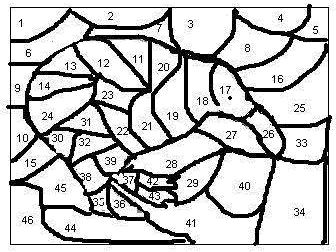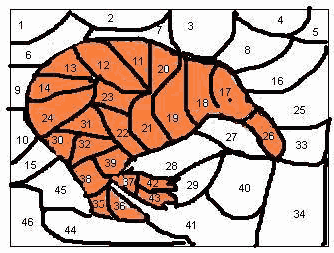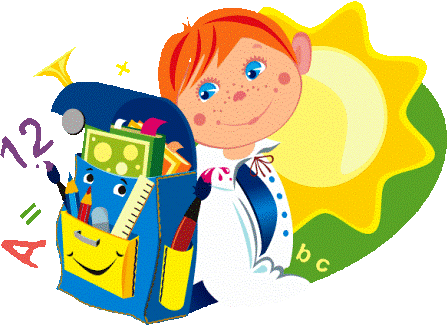Procedure
Abstract Shape
Teacher doesn’t write the theme of the lesson on the
blackboard, but
draws an abstract shape on the blackboard, which slightly reminds both
the shape of New
Zealand and a cloud. And the students are puzzled what it is. Teacher
asks them to
describe the shape, they come with different ideas
E.g. "It’s a stone”
"It’s a bone”
Answers will vary.
Draw pupils’ attention that it also looks like a
cloud – long white
cloud.
Ask what country is associated with a long white
cloud. Lead the
discussion to the right answer: New Zealand (Because the Maori people,
native people of
New Zealand, named it as the country of a long white cloud).
Interactive Listening
Look at the map and ask one of the students to change your abstract
shape in order to
look it like a shape of New Zealand on the map.
Give the students Handout 1 and ask them to follow
the instructions.
Handout 1
A Fold this page along the dotted line. Look at B.
B A girl from New Zealand is writing a letter to you
mentioning the
main facts about her country. Predict two kinds of information you will
hear (receive).
Write it.
C Listen. Did you hear any of your predictions in B.
Fold here
…………………………………………………………………………………………………………
Listen again and complete the letter. Remember that you can ask
questions or ask the
teacher to repeat any time.
 Hello! My name is Emily and
I live in the capital of … , Wellington. I am 11 years old. Hello! My name is Emily and
I live in the capital of … , Wellington. I am 11 years old.
First of all, New Zealand is an … in the Southwest … .
New Zealand is part of a … called … .
Our country is made up of … called the North and the …
Island.
There are also … smaller islands. … is a mild and moist
country, and
…
falls throughout most of the year, but … in the …
. If you
come to …, you will … that New Zealand is a … …
We have snow-capped … , … lowlands, beaches, and lots of …
and
waterfalls. You will also find out that we speak … (with a
British accent).
But there are two official languages in our country (English and Maori).
Popular sports here are … (like football), cricket (like …
), and
soccer.
Many people love to … (including my dad). In the mountains, you
can … and
… . In the water you can … , … , scuba dive, or surf. I
love to
tramp ( … to Americans). Steve loves to … … .
The Dutch were the … … to spot New Zealand. Then the …
came. New …
soon became an important whaling, sealing, and trading base. More
Europeans came because
of the … … and the … … here.
New Zealand became a … … after many Maori (the native people of
New Zealand)
chiefs and repersenitives of the British Crown. Then the Maori lost a
lot of their land.
Then, in 1858, the … made one of their chiefs, Potatau Te
Wherouwhero, …
.
One of my favorite foods is … with extra dead horse ( …
sauce to
Americans).
I also enjoy … without the dead horse. … is the meat
staple here, though
Steve refuses to eat it. He lives off mainly candy.
I hope you enjoyed hearing about my … … and that someday you will
come and
visit New … .
Well, Good-bye!
Text for Listening comprehension (For Teacher)
Hello! My name is Emily and I live in the Capital of New Zealand,
Wellington. I’m 11
years old.
First of all, New Zealand is an island country in the Southwest Pacific
Ocean. New Zealand
is part of a large island group called Polynesia. Our country is made up
of two main
islands called the North Island and the SouthIsland. There are also many
smaller islands.
New Zealand is a mild and moist country, and rain falls throughout most
of the year, but
more in the winter. If you come to visit, you will find that New Zealand
is a beautiful
country. We have snow-capped mountains, green lowlands, beaches, and
lots of lakes and
waterfalls. You will also find out that we speak English (with a British
accent).But there
are two official languages in our country (English and Maori).
Popular sports here are rugby (like football), cricket (like baseball),
and soccer. Many
people love to sail (including my dad). In the mountains, you can ski
and climb. In the
water you can fish, swim, scuba dive, or surf. I love to tramp (hike to
Americans). Steve
loves to play rugby.
The Dutch were the first people to spot New Zealand.
Then the British came. New Zealand soon became an important whaling,
sealing, and trading
base. More Europeans came because of the good farming and the nice
climate here.
New Zealand became a British colony after many Maori (the native people
of New Zealand)
chiefs and repersenitives of the British Crown. Then Maori lost a lot of
their land. Then,
in 1858, the Maori made one of their chiefs, Potatau Te Wherouwhero,
king.
One of my favorite foods is pizza with extra dead horse (tomato sauce to
Americans). I
also enjoy spaghetti without the dead horse. Lamb is the meat staple
here, though Steve
refuses to eat it. He lives off mainly candy.
I hope you enjoyed hearing about my beautiful country and that someday
you will come and
visit New Zealand.
Well, Good-bye!
Show Time. Position on the Earth’s Surface.
Teacher: Look at the map (globe). Where is new Zealand
situated? Where
did you receive the letter from? Do you know the address?
Every place has a "global address” that tells exactly where in the world
it’s
located, just as a street address.
There are two numbers in a global address: a number for latitude and one
for longitude. If
you know these numbers and how to use them, you can find any place in
the world and give
its absolute location.
Here they are for New Zealand:
41 00 S
174 00 E
Remember them!
Point to the country on the map. So, New Zealand lies in the Southern
Hemisphere.
Explain that as the earth travels around the sun, first the top half and
then the bottom
half of the world leans forward the sun. This means that when it is
summer in a country in
the top half of the world, in Canada or in Russia, it is winter in New
Zealand.
Put stickers on the map as it is shown in the picture 1.
M & Ms season game.
Each student is taking one M & Ms candy (or
coloured paper) at the
beginning and they are told not to eat firstly.
A chart of what task each M & Ms represent is presented and
explained.
For teacher:
Green |
Name one spring
month in New Zealand |
Red |
Name one summer
month in New Zealand |
Yellow/orange |
Name one autumn
month in New Zealand |
Purple |
Name one winter
month in New Zealand |
Then students must give answers according to the
colour of their M
& Ms candy.
Some students are asked to fill in the right answers on the blackboard.
The result should be as it is shown below.
Spring |
September,
October, November |
Summer |
December,
January, February |
Autumn |
March, April, May |
Winter |
June, July,
August |
Hidden shape in the puzzle.
Distribute the text and handout 2. Ask students to
read the text
firstly, then read the double choice tasks carefully. Check that they
know what they mean.
Tell them that if they choose all the right alternatives a recognizable
shape will appear
in the middle of the picture puzzle. If not – well, they should try
again with your
help. The students must colour in the corresponding space.
The last step is showing the pictures and reading the text.
Key answers for the text:
11,12,13,14,17,18,19,20,21,22,23,24,26,30,31,32,35,36,37,38,39,42,43.
Text for Reading
Another letter from Emily.
Hello!
In this letter I 13 am/1 is going to answer 2 you/
14 your
questions about my pet.
I 3 has/ 11 have a pet kiwi. I’m 17 talking/4 talked
about
the bird kiwi, not the
12 fruit/5 frut kiwi and a pet rat. The
reason that 20
have/6 having a pet kiwi is because my parents
18 are/7 is animal rescues. They 8
will find/21
found this rare bird 26 on/9 in the road.
It was 10 to/19 too hurt to go back into the wild, so mom 23
and/15
end dad 30 gave/16 given him to me. Sadly this
happens a lot and mom
and dad 22 can’t/25 mustn’t save all of them.
Kiwis 27 are growing/31 grow about the
size of a chicken
and weigh 24 between/28 more three and nine pounds. They 29
has no/32
have no tail and tiny 33 wing/35 wings, but they
can’t fly. Using
its excellent sense of smell and a bill, a kiwi 37 eats/34 drinks
insects,
berries and seeds.
It 36 has/41 have 40 an/38 a
wiry coat of
grey or brown appearance, whiskers like a cat.
The Maori found that bird’s feathers made fine
coverings for their
cloaks (clothing).
It 43 was/45 were the Maori who gave
the 46 burd/42
bird its name taking it from the shrill cry that the bird makes.
That sound like
"kee-wee”
Handout 2

For teacher: is the correct result.

Kiwi Time.
Students must answer teacher’s question using the
sound "kee-wee”
How do people call a small brown bird in new
Zealand who cannot fly
How do people call the New Zealand dollar
How do people call fruit (green inside, brown
outside)
How do people call international symbol of New
Zealand
How do people call New Zealanders
Shape stories.
Give students a small size kiwi-shaped paper (either
bird or fruit or
dollar) and ask them to write 3 things they’ve learnt about New Zealand.
Then they
staple or glue it on the kiwi-bird they coloured before (reading the
text) and share with
others.
Drama Time.
At the same time as one group of students is writing
shape stories the
other group of students try to dramatize Maori Legend "How the Kiwi Lost
its Wings” or
it can be prepared beforehand to show at the end of the lesson.
How the Kiwi Lost his Wings
One day, Tanemahuta was walking through the
forest. He looked up at
his children reaching for the sky and he noticed that they were
starting to sicken, as
bugs were eating them.
He talked to his brother, Tanehokahoka, who called all of his
children, the birds of
the air together.
Tanemahuta spoke to them.
"Something is eating my children, the trees. I need one of
you to come down
from the forest roof and live on the floor, so that my children
can be saved, and your
home can be saved. Who will come?"
All was quiet, and not a bird spoke.
Tanehokahoka turned to Tui.
"E Tui, will you come down from the forest roof?"
Tui looked up at the trees and saw the sun filtering through
the leaves. Tui looked
down at the forest floor and saw the cold, dark earth and
shuddered.
"Kao, Tanehokahoka, for it is too dark and I am afraid of
the dark."
Tanehokahoka turned to Pukeko.
"Pukeko, will you come down from the forest roof?"
Pukeko looked down at the forest floor and saw the cold, damp
earth and shuddered.
"Kao, Tanehokahoka, for it is too damp and I do not want to
get my feet
wet."
All was quiet, and not a bird spoke.
Tanehokahoka turned to Pipiwharauroa.
"Pipiwharauroa, will you come down from the forest roof?"
Pipiwharauroa looked up at the trees and saw the sun filtering
through the leaves.
Pipiwharauroa looked around and saw his family.
"Kao, Tanehokahoka, for I am busy at the moment building my
nest."
All was quiet, and not a bird spoke. And great was the sadness
in the heart of
Tanehokahoka, for he knew, that if one of his children did not
come down from the forest
roof, not only would his brother loose his children, but the birds
would have no home.
Tanehokahoka turned to Kiwi.
"E kiwi, will you come down from the forest roof?"
Kiwi looked up at the trees and saw the sun filtering through
the leaves. Kiwi looked
around and saw his family. Kiwi looked at the cold damp earth.
Looking around once more,
he turned to Tanehokahoka and said,
"I will."
Great was the joy in the hearts of Tanehokahoka and Tanemahuta,
for this little bird
was giving them hope. But Tanemahuta felt that he should warn kiwi
of what would happen.
"E kiwi, do you realise that if you do this, you will have
to grow thick,
strong legs so that you can rip apart the logs on the ground and
you will loose your
beautiful coloured feathers and wings so that you will never be
able to return to the
forest roof. You will never see the light on day again."
All was quiet, and not a bird spoke.
"E kiwi, will you come down from the forest roof?"
Kiwi took one last look at the sun filtering through the trees
and said a silent
goodbye. Kiwi took one last look at the other birds, their wings
and their coloured
feathers and said a silent goodbye. Looking around once more, he
turned to Tanehokahoka
and said,
"I will."
Then Tanehokahoka turned to the other birds and said,
"E Tui, because you were too scared to come down from the
forest roof, from now
on you will wear the two white feathers at your throat as the mark
of a coward.
Pukeko, because you did not want to get your feet wet, you
will live forever in the
swamp.
Pipiwharauroa, because you were too busy building your nest,
from now on you will
never build another nest again, but lay your eggs in other birds
nests.
But you kiwi, because of your great sacrifice, you will
become the most well known
and most loved bird of them all."
|
Materials
Blackboard, chalk
World map or globe
New Zealand Map
M & Ms candies or pieces of coloured paper
Handouts
Small papers for writing
Glue or stapler
Pictures of summer and winter or their symbols
| Topic |
New Zealand |
| Level |
Intermediate |
| Skills |
Speaking
Listening Comprehension
Reading
Writing |
| Language Focus |
Present Simple
Past Simple |
| Vocabulary Focus |
Geographical names
Month
Seasons
Other |
| Exam Focus |
Speaking
Information Transfer |
| Other |
Memory, imagination, fun |
|

